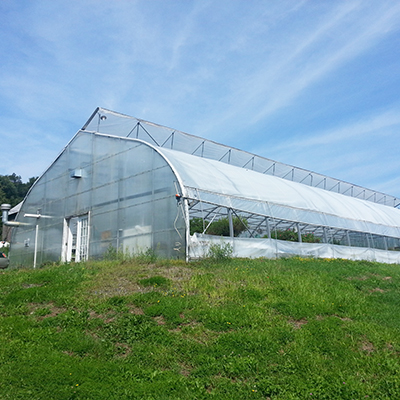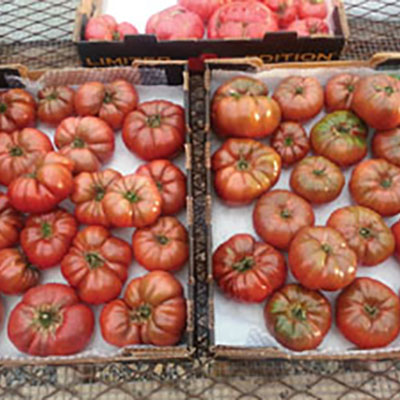Why two of our hoophouses are named because of Emily
By Andrew Mefferd

2011 was a big year for us on One Drop Farm. We built three hoophouses and had our first child.
I keep being reminded of the beginning of the decade even though it’s almost 2020 because our apprentice from 2011, Emily Eckhardt, has moved back to town and we couldn't be more excited! We’ve had a lot of changes on our farm and perhaps the reminders of the past that are now present again have put me in a reflective mood.
Whenever I have to remember when Emily worked on our farm, all I do his think back to when my son Jasper was born and I remember that she was here in 2011. At the time, I was working full-time for Johnny’s Selected Seeds, my wife was managing the farm more than full-time, and I did what I could on evenings and weekends.
We were growing vegetables for our town of Skowhegan, Maine’s farmers market and for local wholesale. With a baby on the way and three hoophouses to be built, there was a lot of flux on the farm that spring and Emily was a huge part of making that year a success.
The first thing we built after the truck dropped off the thousands of pounds of steel pipes and parts was a 20 x 48 hoophouse to use as a nursery/propagation house. Then we moved on to a 30 x 48 hoophouse for tomatoes. I use the picture of that hoophouse a lot in presenations, because I have a photo of it all planted up with tomatoes, without any endwalls on it, so you can see how we used to grow tomatoes. For more on that and other changes we made to our hooophose growing, click here. The construction ran so late that we planted the tomatoes before we were done building the tunnel so they could get in the ground and stop getting rootbound in their pots.

Once we finally got the end walls on, Emily, who is from Florida, said that it reminded her of the heat and humidity of Gainesville where she's from. So, to this day that greenhouse’s name is Gainesville.
As soon as we were done with Gainesville we moved on to building another 30 X 48 hoophouse. We were hoping to get all the construction done before the baby came. That’s how we found ourselves in mid-August with a mostly built but uncovered hoophouse frame. I still remember my wife Ann coming up to me as I was screwing wiggle wire track to the corner of that hoop house and saying, “I think I'm in labor.” We took a walk down around our field to get things moving and the next morning our son was born in our living room.
I took two weeks off of work and as anyone who's ever had a baby knows, that kicked off a maelstrom of baby love and poop and vomit, and not a lot of sleep. While also trying to maintain momentum on the farm. Emily was a critical part of keeping things going through that time.
We did a lot of work on that second hoophouse over the two weeks that I had off of work after Jasper came into the world. By that second and last Friday of my time off, I remember being so excited going to tell Ann that we had the frame done so we could start putting the cover on the next day.
And she said, “You know there's a hurricane coming, right?”
I sure didn’t. As a daily commuter at the time, I was getting a lot of my news from listening to the radio in the car to and from work. Over the two weeks after the baby I hardly went anywhere, and I lost track of the outside world.
We knew we had two options when it came to covering the hoophouse frame. We could either leave it uncovered and the frame would weather the storm without any plastic. Or we could cover it, but we would have to finish the job entirely by the time the storm hit. Any unfinished openings could let the wind in to lift the frame. We couldn't just put on the top and leave the ends off like we did with the first one. (Not something I’d recommend by the way but sometimes you do what you’ve got to.)

Looking back with the benefit of hindsight, I do not think the decision I made was the best one. At the time I was thinking about how we had cucumber transplants that were getting leggier by the day. They were supposed to be our late cuke crop and had nowhere to go until we got the cover on the hoophouse. And I also thought about how the following Monday I had to be back at work. Which would push the covering to the following weekend since I wouldn't have the time to do it during the work week. So, I decided to scramble and get the cover on before the hurricane.
Many New Englanders may remember hurricane Irene as a hurricane that was still strong when it tracked unusually far inland and did much more damage than hurricanes usually do to the region. It was due to hit New England on Sunday August 28, exactly two weeks after Jasper was born.
The preceding Saturday, August 27, we had to do the Skowhegan Farmers Market. Our plan was to do the market in the morning and cover the hoop house after the market. Surprise, surprise, that was an overly ambitious plan for the day. The sun went down on us after the market on Saturday with the big piece of plastic on the top of the greenhouse but no end walls. And the wind was picking up.
We asked Emily if, despite the fact that Sunday was her day off, she would help us put the end walls on the following morning in the storm and she immediately agreed. We got up the next morning to high winds, lashing rain and Emily in head-to-toe rain gear. My parents were in town to see the new baby, so she my Dad and I went out into the storm to get the end walls on.
We had already framed the structure for the end walls out of two-by-fours, so all we had to do was tack the plastic to it. Unfortunately, this involved staple-gunning plastic in high wind and heavy rain.
I’ve never worked on a fishing boat or anything like that, but to this day that was some of the worst weather I’ve ever worked in. At first I hesitated to even go out thinking, “How can we possibly put plastic on in weather like this?” But we kept going because we knew the wind would probably demolish the structure if we didn’t finish it right away.
Halfway through the job our friend Scott Barden showed up. Being an extremely handy guy, Scott had helped us a lot with the initial construction of all the hoophouses. And he knew we were out working on them in the storm that day. I’ll always remember him pulling up in his pick-up truck in the rain, putting on a wide-brimmed waterproof hat, whipping out his hammer tacker and helping us get those end walls on. We never would have been able to get the job done where it not for the help of Emily, Scott and my dad.
Somehow or another we did get all the plastic on. Because we were in such a hurry, we hadn't even gotten our rollup sides on, so I just tacked the sides down as tight as possible with old drip tape to keep the plastic from ripping off the staples. To this day that greenhouse is known as Irene for having survived.
In addition to having Emily around again for the first time in eight years, it is because of her that we also have livestock on the farm for the first time in the same amount of time. We have actually had quite a bit of livestock off and on over the years. We had a family milk cow named Tiny, who was a small Jersey retired by our local organic dairy. Along with tiny we had a couple steers, as many as three or four hundred laying hens at certain times, and when Emily was here in 2011 we had a small flock of Katahdin sheep. However, those sheep got caseous lymphadenitis so we culled them later in 2011.
In addition to having the animal products to complement our vegetables, we also liked the idea of having livestock on our farm in order to close the circle and reduce or eliminate off-farm inputs of compost. I was reminded of this when I was doing interviews for my book The No-Till Organic Farming Revolution. When I interviewed Jay Armor of Four Winds farm, he told me the main reason he had his beef cows was for their manure. Read what Jay wrote about his innovative forced-air composting system a year ago in the January 2019 Growing for Market here. I want to build one just like it, which is why I need the manure.

In the intervening years since Emily was last on our farm, she worked on farms in Florida, Alaska, California and points in between. We wanted to hire her for our farm forever, though we only had another apprentice position open the next season. And we thought she would develop a lot more as a farmer by working for a different kind of farm operation the next season, which she did. So, like anything you love and let go, we were afraid she was gone from us forever excepting occasional visits. That’s why we felt so lucky when she moved back to our little town in Maine.
Now she works for Maine Grains, a company built around a grist mill in a Civil War era jail, helping foster the resurgence of local grain growing, giving Maine farmers an outlet for milling and selling local grains. Click here for an only slightly dated profile of the organization that I wrote back in 2012 called “Small town develops a local food hub.” I guess it’s time we write another one about the great things Maine Grains is doing these days…
Emily has a thing for dairy animals and is scheming about starting a dairy-based business. Here’s a hint: she bought a used soft-serve ice cream maker from my dad. We encouraged her to consider putting some dairy animals in our barn. We’ll have 18 months before they even make any milk, plenty of time to figure out the details! So, a couple of weeks ago she bought two Jersey calves she named Blueberry and July, who now reside in our barn and make it smell good again.
One of the best things about having her calves on our farm is we get to see a lot more of Emily and Dillon. The calves turned out to have coccidiosis when we got them, so we've been doing more intensive chores then we anticipated to get them back to being healthy.
In the intervening years there’ve been a lot of other changes on our farm. 2016 was a huge year of change for us. We stopped doing farmers markets with produce (now only seedlings) that year as we accommodated two new businesses on the farm. January 2016 is when I took over Growing for Market from Lynn Byczynski. That same year Ann took over an established nursery business and re-launched it from our farm as Seedlings by Annie. We had always done a lot of seedlings to get cash flowing in the spring. When opportunity knocked, we thought it made sense for us to grow that part of the business.
This winter I’m feeling grateful to be surrounded by people like Emily and Dillon and my family, and that we are all by and large healthy. 2019 was also big year of change for us to, as we grew hemp for the first time, and I started a hemp seed business with a friend. More on that later. So that’s what’s going on my farm, and why I keep getting friendly reminders of 2011 as we head into 2020.
Andrew Mefferd is the Editor of Growing for Market and farms in central Maine.


 As soon as we start driving our routes in the spring our customers ask us when we’ll have roselilies. They’re that popular and have become a signature crop for us. They’re basically a type of oriental lily, but with multiple layers of petals, and without stamens and pistils (i.e. no pollen!).
As soon as we start driving our routes in the spring our customers ask us when we’ll have roselilies. They’re that popular and have become a signature crop for us. They’re basically a type of oriental lily, but with multiple layers of petals, and without stamens and pistils (i.e. no pollen!). 


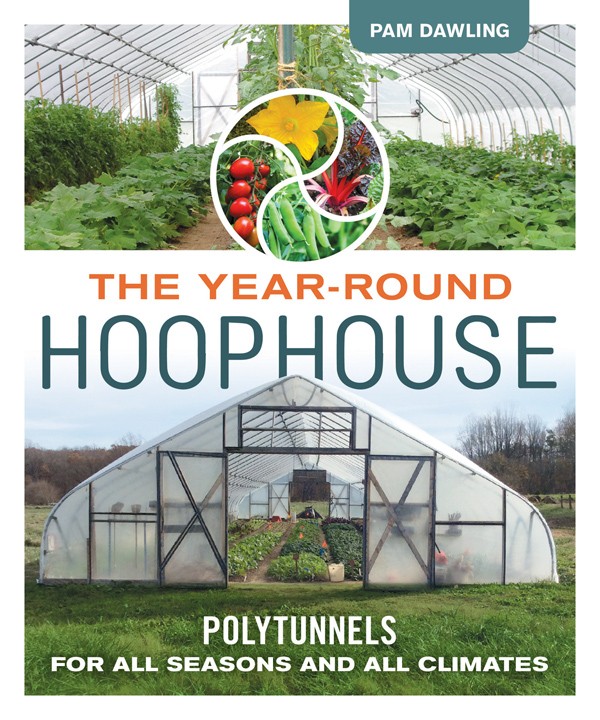 In the hoophouse plants grow bigger and faster. We want to avoid anything that slows growth down. All that growing burns up the organic matter and nutrients in the soil at a fast rate, particularly in hot, humid climates. We need to replenish the soil more generously and more often than we do outdoors. Good soil health means having enough plant nutrients, not surplus. If you have too much soluble nitrogen (N), it can leach into the groundwater or burn up the organic matter. Using manure or compost for a nitrogen source can cause the build-up of excess phosphorus (P).
In the hoophouse plants grow bigger and faster. We want to avoid anything that slows growth down. All that growing burns up the organic matter and nutrients in the soil at a fast rate, particularly in hot, humid climates. We need to replenish the soil more generously and more often than we do outdoors. Good soil health means having enough plant nutrients, not surplus. If you have too much soluble nitrogen (N), it can leach into the groundwater or burn up the organic matter. Using manure or compost for a nitrogen source can cause the build-up of excess phosphorus (P).
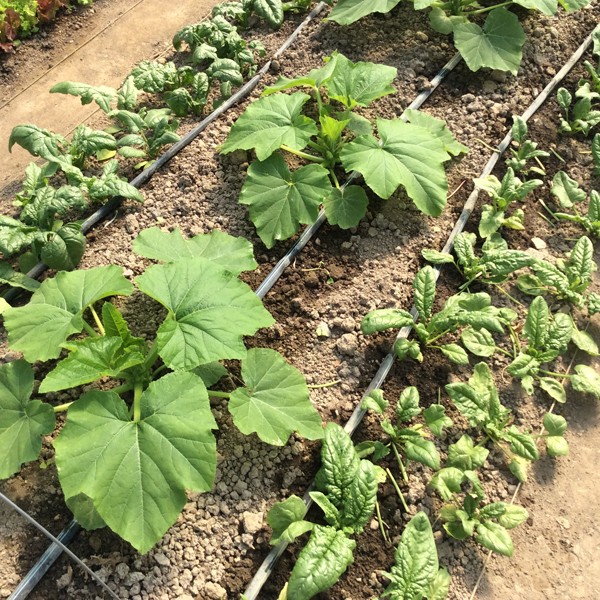 We have three main seasons in our zone 7 central Virginia hoophouse: fall-winter (October to March), spring-early summer (March to July) and high summer (August and September). We grow one bed (90’/27.5 m or so) each of yellow squash and bush cucumbers in the spring-summer season, for reliable early harvests and to help with crop rotation. If you farm in a colder climate than ours, you might be questioning allocating the precious real estate to a crop that so quickly goes from desirable to over-abundant, especially when there are more profitable things to give the space to. One reason is a difference between southern and northern climates.
We have three main seasons in our zone 7 central Virginia hoophouse: fall-winter (October to March), spring-early summer (March to July) and high summer (August and September). We grow one bed (90’/27.5 m or so) each of yellow squash and bush cucumbers in the spring-summer season, for reliable early harvests and to help with crop rotation. If you farm in a colder climate than ours, you might be questioning allocating the precious real estate to a crop that so quickly goes from desirable to over-abundant, especially when there are more profitable things to give the space to. One reason is a difference between southern and northern climates.
 Local and organic ginger is a high-value crop that in the right market can be in high demand. Growing this tropical crop in the Midwest can be a challenge, and thus far, farmers thought they had to own a high tunnel to ensure adequate heat during the variable spring and fall seasons. High tunnel space on most farms is at a premium, so it is expensive space to devote to a long-season crop.
Local and organic ginger is a high-value crop that in the right market can be in high demand. Growing this tropical crop in the Midwest can be a challenge, and thus far, farmers thought they had to own a high tunnel to ensure adequate heat during the variable spring and fall seasons. High tunnel space on most farms is at a premium, so it is expensive space to devote to a long-season crop. 
 With protected space on the farm at a premium, we have to choose wisely when deciding which crops are worth putting under cover. We start out by deciding what to grow overall, and then deciding how much of that can fit inside structures, by doing a little revenue and profit analysis. Quickbooks is used to record sales, so it’s easy to list sales per item at the end of the year to see what brought in the most revenue. A version of that report extracted to a spreadsheet calculates profit per square foot by first subtracting the costs of plugs or bulbs, and then dividing by the cultivated area for each item.
With protected space on the farm at a premium, we have to choose wisely when deciding which crops are worth putting under cover. We start out by deciding what to grow overall, and then deciding how much of that can fit inside structures, by doing a little revenue and profit analysis. Quickbooks is used to record sales, so it’s easy to list sales per item at the end of the year to see what brought in the most revenue. A version of that report extracted to a spreadsheet calculates profit per square foot by first subtracting the costs of plugs or bulbs, and then dividing by the cultivated area for each item. 
 Prairie Garden Farm has been growing cut flowers for florists and studio designers since 2010. As we’re on an exposed hillside in west-central Minnesota, we’re dependent on protected culture to grow quality flowers. This article describes our approach – planning, financial, and operational details - that helps us make the most of our structures.
Prairie Garden Farm has been growing cut flowers for florists and studio designers since 2010. As we’re on an exposed hillside in west-central Minnesota, we’re dependent on protected culture to grow quality flowers. This article describes our approach – planning, financial, and operational details - that helps us make the most of our structures.
 When we talk about high salt levels in soils we do not mean simply sodium chloride, as we would if we complained of too much salt in our soup. “Salts” in the agricultural sense means all soluble ions or nutrients - nitrate, ammonium, potassium, calcium, magnesium, chloride and sulfate. Remember that these are essential nutrients – they are our friends. As with much in agriculture, soluble salt concentration is a matter of balance.
When we talk about high salt levels in soils we do not mean simply sodium chloride, as we would if we complained of too much salt in our soup. “Salts” in the agricultural sense means all soluble ions or nutrients - nitrate, ammonium, potassium, calcium, magnesium, chloride and sulfate. Remember that these are essential nutrients – they are our friends. As with much in agriculture, soluble salt concentration is a matter of balance.
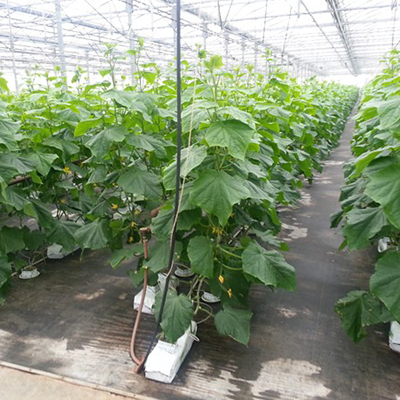
 I’ve often wondered why more market growers don’t use umbrella pruning for greenhouse and hoophouse cucumbers. It’s probably the most common way of growing cukes in greenhouses, and translates well to hoophouses and smaller structures with trellising in the 6-7’ range. I’m pretty sure the reason it’s not used more is unfamiliarity, since most smaller growers I’ve talked with don’t know about it. It’s called umbrella style because the main stem is grown up a string (the umbrella handle), topped at the wire, and two suckers are allowed to grow out to each side (the umbrella canopy).
I’ve often wondered why more market growers don’t use umbrella pruning for greenhouse and hoophouse cucumbers. It’s probably the most common way of growing cukes in greenhouses, and translates well to hoophouses and smaller structures with trellising in the 6-7’ range. I’m pretty sure the reason it’s not used more is unfamiliarity, since most smaller growers I’ve talked with don’t know about it. It’s called umbrella style because the main stem is grown up a string (the umbrella handle), topped at the wire, and two suckers are allowed to grow out to each side (the umbrella canopy).